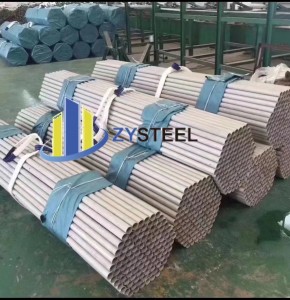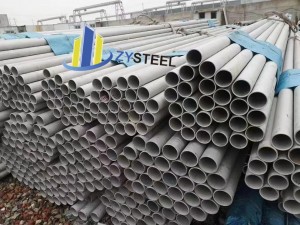-

Stainless steel decorative steel pipe
Stainless steel decorative pipe is also called stainless steel welded steel pipe, which is called welded pipe for short. Usually, steel or steel strip is welded into steel pipe after being crimped and formed by the unit and mold. The production process of welded steel pipe is simple, the production efficiency is high, there are many varieties and specifications, and the equipment cost is small, but the general strength is lower than that of seamless steel pipe.
There are many kinds of stainless steel pipes, but they are mainly used for the following purposes:
1、 Classification of stainless steel pipes
1. Classification by production method:
(1) Seamless pipe – cold drawn pipe, extruded pipe, cold rolled pipe.
(2) Welded pipe:
(a) According to process classification – gas shielded welding pipe, arc welding pipe, resistance welding pipe (high frequency, low frequency).
(b) It is divided into straight welded pipe and spiral welded pipe according to the weld.
2. Classification according to section shape: (1) round steel pipe; (2) Rectangular tube.
3. Classification by wall thickness – thin wall steel pipe, thick wall steel pipe
4. Classified by use: (1) Civil pipes are divided into round pipes, rectangular pipes and flower pipes, which are generally used for decoration, construction, structure, etc;
(2) Industrial pipe: steel pipe for industrial piping, steel pipe for general piping (drinking water pipe), mechanical structure/fluid delivery pipe, boiler heat exchange pipe, food sanitation pipe, etc. It is generally used in various fields of industry, such as petrochemical, paper, nuclear energy, food, beverage, medicine and other industries with high requirements for fluid medium.
2、 Seamless steel pipe
Stainless steel seamless pipe is a kind of long steel with hollow section and no joints around.
1. Manufacturing process and flow of seamless steel pipe:
Smelting>ingot>steel rolling>sawing>peeling>piercing>annealing>pickling>ash loading>cold drawing>head cutting>pickling>warehousing
2. Features of seamless steel pipe:
It is not difficult to see from the above process flow: first, the thicker the wall thickness of the product, the more economical and practical it will be. The thinner the wall thickness, the higher the processing cost will be; Secondly, the process of the product determines its limitations. Generally, the precision of seamless steel pipe is low: uneven wall thickness, low brightness of the surface inside and outside the pipe, high sizing cost, and there are pits and black spots on the surface inside and outside the pipe, which are difficult to remove; Third, its detection and shaping must be processed offline. Therefore, it has its advantages in high pressure, high strength and mechanical structure materials.
3、 Welded steel pipe
304 stainless steel decorative tube
304 stainless steel decorative tube
Welded steel pipe, referred to as welded pipe for short, is a stainless steel pipe welded from steel plate or steel strip after being crimped and formed by the machine set and mold.
1. Steel plate>Splitting>Forming>Fusion welding>Induction bright heat treatment>Internal and external weld bead treatment>Shaping>Sizing>Eddy current testing>Laser diameter measurement>Pickling>Warehousing
2. Features of welded steel pipe:
It is not difficult to see from the above process flow: first, the product is produced continuously and online. The thicker the wall thickness, the greater the investment in the unit and welding equipment, and the less economical and practical it is. The thinner the wall, the lower its input-output ratio will be; Secondly, the process of the product determines its advantages and disadvantages. Generally, the welded steel pipe has high precision, uniform wall thickness, high internal and external surface brightness of stainless steel pipe fittings (the steel pipe surface brightness determined by the surface grade of the steel plate), and can be arbitrarily sized. Therefore, it embodies its economy and beauty in the application of high-precision, medium-low pressure fluid.
There is chlorine ion in the use environment. Chlorine ions exist widely, such as salt, sweat, sea water, sea breeze, soil, etc. Stainless steel corrodes rapidly in the presence of chloride ions, even surpassing ordinary low-carbon steel. Therefore, there are requirements for the use environment of stainless steel, and it is necessary to wipe it regularly to remove dust and keep it clean and dry.
316 and 317 stainless steels (see below for the properties of 317 stainless steels) are molybdenum containing stainless steels. The molybdenum content in 317 stainless steel is slightly higher than that in 316 stainless steel. Because of the molybdenum in the steel, the overall performance of this steel is better than 310 and 304 stainless steel. Under high temperature conditions, when the concentration of sulfuric acid is lower than 15% and higher than 85%, 316 stainless steel has a wide range of uses. 316 stainless steel also has good chloride corrosion resistance, so it is usually used in marine environment. With the development of social economy, the application of stainless steel pipe has also been more and more popular. It will bring new changes in all fields.
-

316 stainless steel pipe
Metals used in petroleum, chemical, medical, food and light industry
316 stainless steel pipe is a kind of hollow long round steel, which is widely used in oil, chemical, medical, food, light industry, mechanical instruments and other industrial transmission pipelines and mechanical structural components. In addition, when the bending and torsional strength are the same, the weight is relatively light, so it is also widely used to manufacture mechanical parts and engineering structures. It is also commonly used to produce various conventional weapons, barrels, shells, etc.
The maximum carbon content of 316 stainless steel pipe is 0.03, which can be used in applications where annealing is not allowed after welding and maximum corrosion resistance is required.
316 and 317 stainless steels (see below for the properties of 317 stainless steels) are molybdenum containing stainless steels.
The overall performance of this steel is better than 310 and 304 stainless steel. At high temperature, when the concentration of sulfuric acid is lower than 15% and higher than 85%, 316 stainless steel has a wide range of uses.
316 stainless steel plate, also known as 00Cr17Ni14Mo2, corrosion resistance:
The corrosion resistance is better than 304 stainless steel, and it has good corrosion resistance in the production process of pulp and paper.
The carbide precipitation resistance of 316 stainless steel is better than that of 304 stainless steel, and the above temperature range can be used.
Varieties: 316 stainless steel tubes, 316 stainless steel bright tubes, 316 stainless steel decorative tubes, 316 stainless steel capillary tubes, 316 stainless steel welded tubes, 304 stainless steel tubes.
The maximum carbon content of 316L stainless steel pipe is 0.03, which can be used in applications where annealing is not allowed after welding and maximum corrosion resistance is required.
5 Corrosion resistance
11 316 stainless steel cannot be hardened by overheating.
12 Welding
13 Typical uses: equipment for pulp and paper making, heat exchanger, dyeing equipment, film processing equipment, pipelines, materials for the exterior of buildings in coastal areas
-

304 stainless steel pipe
Yield strength (N/mm2) ≥ 205
Tensile strength ≥ 520
Elongation (%) ≥ 40
Hardness HB ≤ 187 HRB ≤ 90 HV ≤ 200
Density 7.93 g · cm-3
Specific heat c (20 ℃) 0.502 J · (g · C) – 1
Thermal conductivity λ/ W (m · ℃) – 1 (at the following temperature/℃)
20 100 500 12.1 16.3 21.4
Coefficient of linear expansion α/ (10-6/℃) (between the following temperatures/℃)
20~10020~200 20~300 20~400
16.0 16.8 17.5 18.1
Resistivity 0.73 Ω · mm2 · m-1
Melting point 1398~1420 ℃
As stainless and heat-resistant steel, 304 steel pipe is the most widely used equipment for food, general chemical equipment and atomic energy industry.
304 steel pipe is a kind of universal stainless steel pipe, which is widely used to make equipment and parts requiring good comprehensive performance (corrosion resistance and formability).
304 steel pipe has excellent rust and corrosion resistance and good intergranular corrosion resistance.
304 steel pipe material has strong corrosion resistance in nitric acid below boiling temperature with concentration ≤ 65%. It also has good corrosion resistance to alkali solution and most organic and inorganic acids. A kind of high alloy steel that can resist corrosion in the air or in the chemical corrosion medium. Stainless steel is a kind of steel that has beautiful surface and good corrosion resistance. It does not need to undergo surface treatment such as color plating, but gives full play to the inherent surface properties of stainless steel. It is used in many aspects of steel, usually called stainless steel. High alloy steels such as 13 chromium steel and 18-8 chromium-nickel steel are representative of properties.
As stainless and heat-resistant steel, 304 steel pipe is the most widely used equipment for food, general chemical equipment and atomic energy industry.
-

201 stainless steel pipe
Marking method
201 stainless steel pipe – S20100 (AISI. ASTM)
American Iron and Steel Institute uses three digits to mark various standard grade malleable stainless steel floors. Including:
① Austenitic stainless steel is marked with 200 and 300 series of numbers;
② Ferritic and martensitic stainless steels are represented by 400 series numbers.
For example, some common austenitic stainless steels are marked with 201, 304, 316 and 310, ferritic stainless steels are marked with 430 and 446, martensitic stainless steels are marked with 410, 420 and 440C, and duplex (austenitic-ferritic) stainless steels, precipitation hardening stainless steels, and high alloys with iron content less than 50% are usually patented or trademarked.
Purpose performance
201 stainless steel tube has the characteristics of acid resistance, alkali resistance, high density and no pinhole. It is used to produce various high-quality materials such as case and bottom cover of watch band. 201 stainless steel pipe can be mainly used in decorative pipe, industrial pipe and some shallow stretched products. Physical properties of 201 stainless steel pipe
1. Elongation: 60 to 80%
2. Tensile stiffness: 100000 to 180000 psi
3. Elastic modulus: 29000000 psi
4. Yield stiffness: 50000 to 150000 psi
A.Round steel preparation; B. Heating; C. Hot rolled perforation; D. Head cutting; E. Pickling; F. Grinding; G. Lubrication; H. Cold rolling; I. Degreasing; J. Solution heat treatment; K. Straightening; L. Pipe cutting; M. Pickling; N. Finished product inspection.
-

stainless steel pipe
Standard: JIS AISI ASTM GB DIN EN BS
Grade: 201, 202, 301, 302, 303, 304, 304L, 310S, 316, 316L, 321, 410, 410S, 420,430, 904L, etc
Technique: Spiral welded, ERW, EFW, Seamless, Bright annealing, etc
Tolerance: ± 0.01%
Processing service: bending, welding, decoiling, punching, cutting
Section shape: round, rectangular, square, hex,oval, etc
Surface finish: 2B 2D BA No.3 No.1 HL No.4 8K
Price term: FOB,CIF,CFR,CNF,EXW
Payment term: T/T, L/C